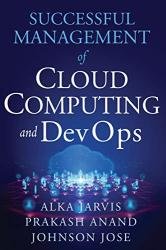 Название: Successful Management of Cloud Computing and DevOps
Название: Successful Management of Cloud Computing and DevOpsАвтор: Alka Jarvis, Prakash Anand, Johnson Jose
Издательство: Quality Press
Год: 2022
Страниц: 273
Язык: английский
Формат: pdf (true)
Размер: 10.1 MB
The rapid pace of technology often catches organizations unprepared and unable to take advantage of every leading-edge benefit. Cloud technology allows forward-thinking companies to launch products and services rapidly, control costs, streamline processes, and mitigate risks—when done correctly. This book addresses technological basics, as well as practical steps for implementing and fitting the cloud into your overall business strategy—which ultimately benefits your bottom line in delivering the best possible product and services to customers quickly.
Capitalizing on their collective years of experience working in Silicon Valley, authors Jarvis, Anand, and Jose share best practices for adopting the cloud, including:
- Calculating cloud usage and crafting a cost management strategy
- Breaking down the total cost of ownership (TCO)
- Optimizing DevOps practices for the cloud
- Understanding the challenges and risks involved with cloud migration and security
Armed with step-by-step guidance, you can generate a plan of action to meet and exceed your cloud management goals.
We have organized the book into three sections: process, technology, and commercial attributes. The decision to move to the cloud is driven by factors other than technology; the process and total cost of ownership (TCO) are important considerations as well.
The first three chapters of the book cover the journey of the technology from the old-fashioned, on-prem data center to modern-world cloud offerings by commercial entities known as cloud service providers (CSPs). We have taken a balanced approach, using examples from the three major CSPs: Amazon Web Services (AWS), Google Cloud Platform (GCP), and Azure. While there are several published training courses and tutorials available, we hope that readers will benefit from our experience in converting the theories into real-life scenarios.
Chapter 4 provides an overview of cloud operations.
Chapter 5 takes a closer look at cloud monitoring and metrics. One of the biggest concerns of the virtual ecosphere is the absence of physical proximity to the devices and network. That invisible domain often creates a sense of panic in the minds of network designers and troubleshooters who were trained by the visible indications of the red, green, and orange lights on the back panel. Therefore, some of the primary offerings from CSPs are related to the detailed and transparent monitoring and measurement of everything going on in the cloud.
The realm of programming and applications is heavily dependent on the underlying hardware, network, and peripherals that connect them all together. Traditionally, these applications were designed to operate on a fully loaded server that contains all of the resources required for it to run smoothly. We guide the reader through a journey from the monolithic world all the way to the latest microservice and serverless world. We are sure that the knowledge gained from this journey will have far-reaching impacts on the mindset of a cloud practitioner. There are many hybrids and intercloud deployment, and it is important to know how various providers use these hybrids to offer their buildups.
Chapters 6 and 7 discuss various cloud providers and how to build and publish an application on the cloud. We also present a view on how cloud providers compare with on-prem data centers and even how the offerings of these providers themselves compare. Parts of Chapters 7 and 8 provide an overall view of how an application can be built from the bottom up and used in all aspects of the cloud. Building applications also involves utilities like IoT and AI/ML, as well as how they fit into the cloud paradigm. Chapter 9 includes best practices for cloud practitioners. As you consider the path forward to full cloud implementation, refer to this chapter for practical guidance.
Скачать Successful Management of Cloud Computing and DevOps